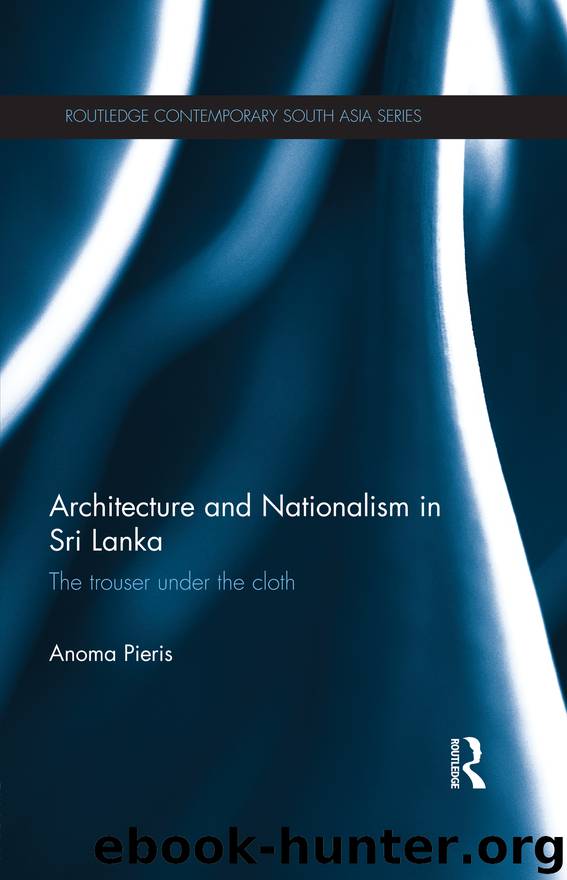Architecture and Nationalism in Sri Lanka by Pieris Anoma

Author:Pieris, Anoma [Anoma Pieris]
Language: eng
Format: epub
ISBN: 9781135115630
Publisher: Taylor and Francis
The reinvention of the vernacular
Andrew Boyd, who first came to Ceylon during the 1920s as a specialist in tea, was inspired by the vernacular tradition to return to England and study architecture. He qualified in 1937 and, following one year’s apprenticeship with Frank Scarlett, came back to the island to set up practice (Hollamby 1962). Among his acquaintances in Ceylon were Wendt, Neruda and Keyt for whom he designed a studio converted from a disused Buddhist temple. His writings were published in Marg.
Boyd denounced the Internationalists and called for a continuity of Indian architecture within a modern idiom (Boyd 1949–1950: 4–8). The alternative, ‘[the] imitation of one’s own architecture in changed conditions is only one degree less disgusting than imitation of foreign forms — less comically odd but more depressingly dead’, he commented (ibid.: 4–8). The gratuitous form-making, which he saw in modern architecture and its concentration within a small group of individuals working for rich private clients, led to its failure, argued Boyd. His solution was an architecture that addressed an understanding and critical public that was constituted ‘in a democratic age’ not by an ‘educated ruling class’ but by ‘the whole mass of the people.’
Boyd’s reference to architecture as a vernacular language, appropriate for engaging the democratic majority, conjured up the imagined community of the nation. In two articles on what he calls ‘A People’s Tradition’, Boyd documented peasant architecture extensively, reproducing Coomaraswamy’s image of a yeoman’s hut and applauding its unpretentious pragmatism. Coherence, economy, simplicity, directness and absence of style were the attributes he highlighted in what he called the ‘Houses by the Road’ (Boyd 1939: 5–8, press).
What are the climate and the way of life that helped to mould the forms of these houses? Tropical sun combined with tropical rainfall dictated the open verandahs, the balconies, the sloping roofs, the generous eaves. And climate, civilized custom and poverty at once contributed to dictate a great simplicity in ordinary life, especially of course among the peasants, and made it possible without much discomfort. The ground was used more than chairs, the mats more than a bed. A leaf was your plate and a few yards of cotton were your everyday clothes.
(Boyd 1947: 30)
Download
This site does not store any files on its server. We only index and link to content provided by other sites. Please contact the content providers to delete copyright contents if any and email us, we'll remove relevant links or contents immediately.
| Africa | Americas |
| Arctic & Antarctica | Asia |
| Australia & Oceania | Europe |
| Middle East | Russia |
| United States | World |
| Ancient Civilizations | Military |
| Historical Study & Educational Resources |
The Sympathizer by Viet Thanh Nguyen(4096)
The Rape of Nanking by Iris Chang(4024)
World without end by Ken Follett(3347)
Ants Among Elephants by Sujatha Gidla(3282)
Blood and Sand by Alex Von Tunzelmann(3060)
Japanese Design by Patricia J. Graham(3005)
City of Djinns: a year in Delhi by William Dalrymple(2438)
Foreign Devils on the Silk Road: The Search for the Lost Treasures of Central Asia by Peter Hopkirk(2389)
Inglorious Empire by Shashi Tharoor(2347)
The Queen of Nothing by Holly Black(2324)
In Order to Live: A North Korean Girl's Journey to Freedom by Yeonmi Park(2304)
India's Ancient Past by R.S. Sharma(2304)
Tokyo by Rob Goss(2295)
India's biggest cover-up by Dhar Anuj(2250)
Tokyo Geek's Guide: Manga, Anime, Gaming, Cosplay, Toys, Idols & More - The Ultimate Guide to Japan's Otaku Culture by Simone Gianni(2244)
The Great Game: On Secret Service in High Asia by Peter Hopkirk(2231)
Goodbye Madame Butterfly(2163)
Batik by Rudolf Smend(2010)
Living Silence in Burma by Christina Fink(1987)
